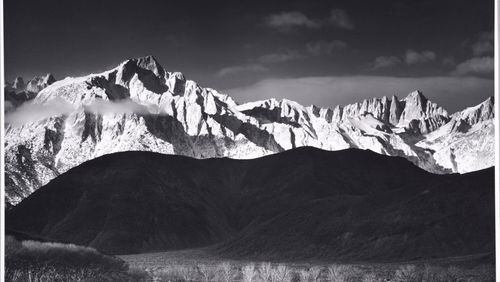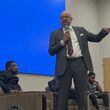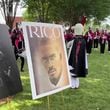EXHIBIT PREVIEW
“Ansel Adams: Before & After”
Exhibit: Through March 20 at Booth Western Art Museum. 10 a.m.-5 p.m. Tuesdays-Saturdays (until 8 p.m. Thursdays), 1-5 p.m. Sundays. $10; $8 age 65 and up; $7 students with an ID; free age 12 and under. 501 Museum Drive, Cartersville. 770-387-1300, www.boothmuseum.org.
Symposium: Photographers and photography scholars involved in "Ansel Adams: Before & After" are featured in four sessions on Adams and those he has inspired as well as the future of photography. 10 a.m.-3:30 p.m. Saturday. $10 (for full day).
John Mariana has built an accomplished career as an image-maker and a teacher of photography, but the Kennesaw photographer admits he's awed by the company he's keeping in "Ansel Adams: Before & After," a major exhibition at Booth Western Art Museum in Cartersville.
Alfred Stieglitz, Edward and Brett Weston, Imogen Cunningham and Dorothea Lange are among the all-time greats of the medium represented in the exhibit focused on photographers who influenced Adams, worked at the same time as peers of the poet of the Western landscape, or are contemporary artists influenced by his legacy.
Works by 26 photographers bookend 23 original Adams prints in the 100-plus-work exhibit. Mariana and National Geographic contributor Peter Essick are the representatives from metro Atlanta in the potent exhibit co-organized by the Booth and Atlanta's Lumière Gallery.
“I was overwhelmed,” Mariana said about the inclusion of three of his color works in the show. “I still really can’t believe it’s there.”
He began to transition from art-making to photography in 1980, and Adams, whose prints he studied closely at the Art Institute of Chicago, was an early influence, one that has endured. Mariana founded the American Photography Academy in Chicago, and served as president of the Chicago Area Photo Clubs Association in 1990, before his career in software systems for transportation management and warehousing brought him to Atlanta in 1996.
He’s continued his affection for large-scale landscapes while conducting weeklong workshops in panoramic places such as Yosemite National Park, Monument Valley, New Mexico, Costa Rica and, soon, Venice and Florence, Italy.
Mariana helped found the Booth Museum Photography Guild in 2010, the same year that the Cartersville institution cemented its commitment to showing photography with the attendance record-setting exhibit "Ansel Adams: A Legacy."
Before he participates in a full-day Booth symposium on the influence of Adams, who died in 1984, and photography's future on Saturday, The Atlanta Journal-Constitution put Mariana in the viewfinder.
Q: How did you become an Adams believer?
A: In the photography club I got involved with in Chicago, there were some really good printers and they started to talk about Ansel's work. Then I read his books, and we would go see his prints at the Art Institute and talk about them, talk about the tonal range.
I attended a program one night and the (lecturer) said, “Ansel said it will take 10 years to be a good black-and-white printer.” And I thought, “Ah, you’re kidding me! Two years, I’ll have this knocked.” Ten years later, I thought, “Maybe another year or two I’ll know what I’m doing.”
Q: What did you learn while examining his prints?
A: I saw the aspects of composition and highlight and shadow. And that's what I kept working on and working on. It is not easy to do in black and white, even with good (printing) papers.
Q: You’ve never lived out West like Adams. Were you attracted to the landscapes he captured or were you more into the idea of trying to do what Adams did technically?
A: The idea. No relevance to me of what I was shooting. In fact, what I got really enthralled with was Gothic architecture. So I started shooting (the Cathedral of) St. Philip in Buckhead. It's beautiful in there, and (a challenge) to capture that the right way …
So the idea of whether it was scenics or out West, it didn’t matter. It was about creating the piece that’s really going to move somebody.
Q: Over the years, many have thought Adams’ magic was his ability to find the right spot and moment, not realizing that he was a master of the darkroom, even creating tools to manipulate his images. How do you rate his darkroom work?
A: He was the most advanced (photographer of his time in the darkroom). The passion of creating something, to make that better and better and better is what I think drove him.
Q: Does that drive you, too?
A: When I'm capturing a digital image, the composition has to be extremely strong and I have to capture all the pixels I need, because I already know how I'm going to work with it after the fact to create the final print.
I get into a lot of discussion with people (who will protest), “Well, that’s not what was there.” Well, I’m not trying to show you what was there! I’m trying to show you what I saw and what I thought about how it was going to look.
Q: Have you thought about where Adams would have been had he lived long enough to take advantage of photography’s technical advancements?
A: First of all, he would be a super Photoshop user, I'm convinced, because all the tools are there. (Back then), it took nearly a half-hour to get a first print through the chemicals, and that was just to see what exposure you needed for your enlarger. Where today on the monitor, you see the changes instantly. He would have just loved it.






